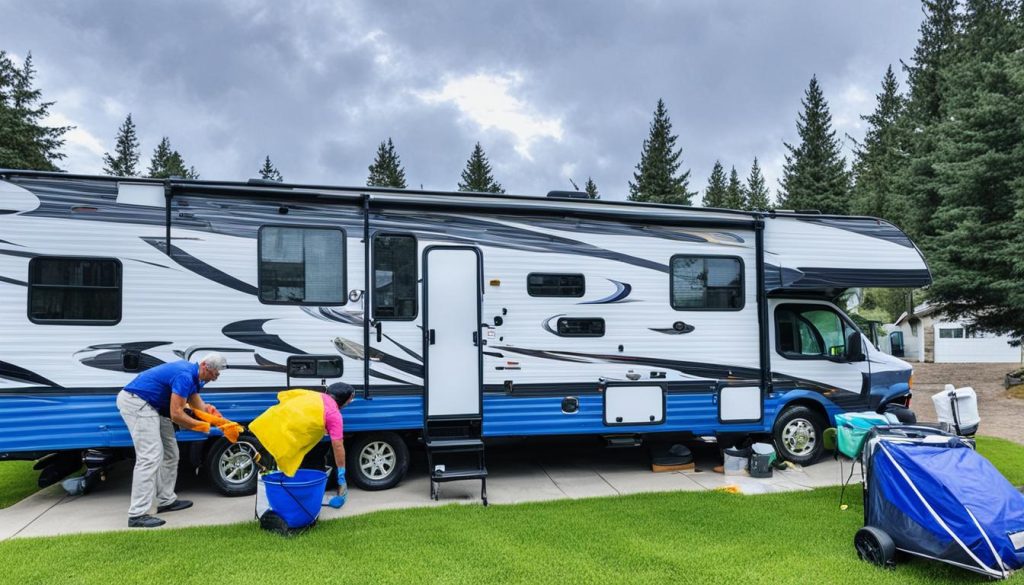Can a simple rule change your RV travel experience? The 3-3-3 rule for RV travel aims to do just that. It makes your trips more enjoyable and safe. But what is it, and how does it help?
For those new to RV travel, this rule is key. It helps make your trips well-organized and memorable. So, what is the 3-3-3 rule for RV travel, and why should every RV enthusiast use it?
Key Takeaways
- Limit daily travel to a maximum of 300 miles to prevent fatigue and burnout.
- Stay at each campground for at least 3 nights to thoroughly enjoy and explore the area.
- Arrive at your destination by 3 PM to secure a good camping spot and avoid late-day stress.
- Alternative rules like the 4-4-4 and 2-2-2 are available for different travel paces.
- First-come, first-serve campsites often fill up early, highlighting the importance of timely arrival.
- Proper travel organization can prevent logistical issues such as campsites already being full or running out of supplies.
By following these simple guidelines, RV travelers can enjoy a more relaxed and fulfilling journey. Using these RV travel tips can greatly improve your experience.
Understanding the 3-3-3 Rule for RV Travel
The three-three-three rule is key for RV travel. It means driving no more than 300 miles a day. You should arrive by 3 p.m. and stay for at least three days. This rule is the heart of good RV travel planning, making your trip enjoyable.
Let’s dive into each part of the three-three-three rule:
- Daily Travel Limit: Driving 300 miles a day is about 4 to 6 hours. This keeps you from getting too tired, keeping you safe.
- Arrival Time: Arriving by 3 p.m. is great. You get daylight to set up, take breaks, and explore. It’s important for a good RV trip.
- Stay Duration: Staying for three days lets you rest and enjoy your place. It makes your trip better.
The three-three-three rule also helps with planning. It’s good to take breaks every three hours. This makes your trip safer and more efficient.
Being flexible is also important. Some like the 2-2-2 rule (200 miles, 2 p.m. arrival, 2 days stay). Others might try the 4-4-4 rule. These rules help avoid too much travel and make your trip richer.
Benefits of Following the 3-3-3 Rule
Following the 3-3-3 rule brings many benefits for RV travel. It makes driving safer by reducing driver fatigue. Studies show that driver discomfort grows after 130 minutes of driving.
This rule limits daily drives to 3 hours. It helps avoid the dangers of tired drivers.
Adopting this rule also means arriving at destinations by 3 p.m. This has many perks. You get to set up camp and explore in daylight.
It makes your camping trip better. You can plan more and make decisions without rushing.
The rule also suggests staying at least 3 days at each spot. This lets you really get to know the area and its culture. It’s a big change from the fast pace of some RV trips.
Staying longer means less packing and setting up. It makes your trip more relaxed and fun.
This travel plan follows important RV rules and tips. It limits daily travel to 300 miles. This helps avoid fatigue and keeps you safe.
Driving in daylight also lowers accident rates. It’s safer and better for your health.
Longer stays let you see famous spots and hidden gems. Each stop becomes a memorable part of your trip. It turns your journey into a series of great experiences.
- Arrive by 3 p.m. to maximize daylight for setting up camp.
- Limit daily driving to 3 hours to minimize driver fatigue.
- Stay for at least 3 days to enhance your travel experience.
By using the 3-3-3 rule, RV travelers can enjoy safer, more fun, and deeper journeys.
Conclusion
The 3-3-3 rule is key for RV travel, helping you enjoy your trips without stress. It limits your daily drive to 300 miles, keeping driving times between 4 to 6 hours. This rule is a must for all RV travelers, helping you avoid fatigue and enjoy the journey more.
Arriving at your campsite by 3 p.m. is also part of the rule. It gives you enough daylight to set up and relax. The rule also suggests staying at least three days at each spot. This lets you explore fully and helps local businesses, making each stop a chance to relax and discover new places.
Using the 3-3-3 rule makes RV travel less stressful. It helps avoid tiredness, rush-hour setup, and too many places to visit. It makes your RV trips safer, more fun, and more rewarding. Whether you’re traveling across the U.S. or in states like Florida and Texas, this rule is essential for a great RV experience.

